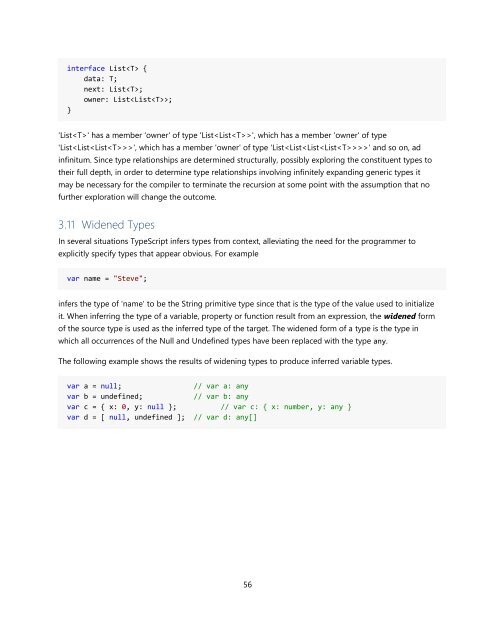TypeScript Language Specification v1.5
TypeScript Language Specification v1.5
TypeScript Language Specification v1.5
Create successful ePaper yourself
Turn your PDF publications into a flip-book with our unique Google optimized e-Paper software.
interface List {<br />
data: T;<br />
next: List;<br />
owner: List;<br />
}<br />
'List' has a member 'owner' of type 'List', which has a member 'owner' of type<br />
'List', which has a member 'owner' of type 'List' and so on, ad<br />
infinitum. Since type relationships are determined structurally, possibly exploring the constituent types to<br />
their full depth, in order to determine type relationships involving infinitely expanding generic types it<br />
may be necessary for the compiler to terminate the recursion at some point with the assumption that no<br />
further exploration will change the outcome.<br />
3.11 Widened Types<br />
In several situations <strong>TypeScript</strong> infers types from context, alleviating the need for the programmer to<br />
explicitly specify types that appear obvious. For example<br />
var name = "Steve";<br />
infers the type of 'name' to be the String primitive type since that is the type of the value used to initialize<br />
it. When inferring the type of a variable, property or function result from an expression, the widened form<br />
of the source type is used as the inferred type of the target. The widened form of a type is the type in<br />
which all occurrences of the Null and Undefined types have been replaced with the type any.<br />
The following example shows the results of widening types to produce inferred variable types.<br />
var a = null;<br />
// var a: any<br />
var b = undefined;<br />
// var b: any<br />
var c = { x: 0, y: null }; // var c: { x: number, y: any }<br />
var d = [ null, undefined ]; // var d: any[]<br />
56


















